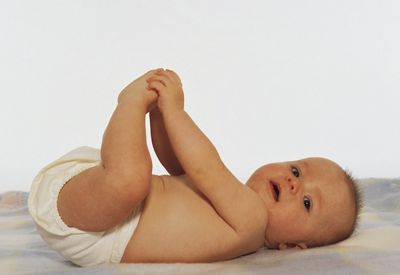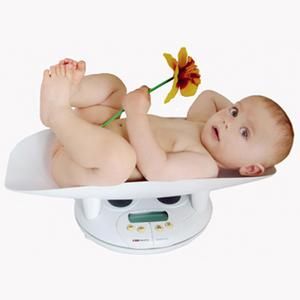Medical expert of the article
New publications
What a child should be able to do before a year - by months
Last reviewed: 04.07.2025

All iLive content is medically reviewed or fact checked to ensure as much factual accuracy as possible.
We have strict sourcing guidelines and only link to reputable media sites, academic research institutions and, whenever possible, medically peer reviewed studies. Note that the numbers in parentheses ([1], [2], etc.) are clickable links to these studies.
If you feel that any of our content is inaccurate, out-of-date, or otherwise questionable, please select it and press Ctrl + Enter.
By the time a child turns one year old, he can already do a lot. His height and weight increase every month, the child develops rapidly. The baby's weight increases by an average of 500-600 grams every month, and his height by 1-2 cm. How does a baby develop month by month up to one year?
By the end of the 1st month the child:
- Raises head briefly
- Can turn head from side to side
- Likes to look at a human face from a distance of 20-25 cm
- Makes sharp hand movements
- Brings hands to face
- May turn head towards familiar voice
- Reacts to loud sounds
- Flashes in bright light
 [ 1 ]
[ 1 ]
By the end of the 2nd month the child:
- Smiles
- Follows objects with his eyes
- Cries when he is unhappy
- Can produce vowel sounds such as "a" or "o"
By the end of the 3rd month the child:
- Raises his head and chest when placed on his tummy
- Raises head up 45 degrees
- Straightens legs when lying on back
- Opens and closes the cam
- Pushes off with its feet when placed on a hard surface
- Reaches for hanging toys
- Grabs and squeezes toys in his hand
- Looks at moving objects
- Begins to imitate sounds
- Recognizes familiar objects and people, even from a distance
- The child begins to develop the so-called social smile
- Hand-eye coordination begins to develop
- Holds head up longer
 [ 4 ]
[ 4 ]
By the end of the 4th month the child:
- May sleep about six hours all night before waking up (total sleep is usually 14 to 17 hours)
- Sits with support
- Raises head 90 degrees
- Can follow a moving object in a 180 degree arc
- Amuses himself with new sounds
- Reacts to all colors and shades
- Explores objects, puts them in mouth
- Can suck on a pacifier or breast
- Shows his pain, fear, loneliness and discomfort through crying
- Reacts to a rattle or bell
By the end of the 5th month the child:

- Draws attention to small objects
- Can see the range of the entire room
- Begins to use both hands to transfer toys from one hand to the other
- The baby begins the process of teething
By the end of the 6th month the baby:
- Holds head up when sitting
- Pronounces some vowel-consonant sounds
- Sits with minimal support
- Opens mouth to take spoon with food
- Grabs the toy
- Trying to crawl
- Drinks water, milk or compote from a cup without a nipple
- Can hold a bottle with his hands
- Tries to copy some facial expressions
- Pronounces the simplest words of two syllables
By the end of the 7th month the child:
- Turns head in the direction of the voice
- Imitates many sounds
- Distinguishes the tone of human emotions
- Sits independently, almost without support
- Crawls
- Rolls from tummy to back and vice versa
- Babble
- Pronounces the syllables "pa", "ma", "ba"
- May not wake up at night
 [ 7 ]
[ 7 ]
By the end of the 8th month, the baby usually:
- Reacts with laughter or a smile to objects that he likes
- Can suck compote or milk from a bottle
- Turns his head when he's finished sucking
- Can sleep about 11-13 hours a day; daytime sleep takes 2 to 3 times (this number may vary)
- Sits without support
- Crawls in a position on knees and hands
- Depending on different needs, he cries differently
- Reacts to his name
- He has different reactions to different family members.
- Shows signs of separation anxiety from parents
By the end of the 9th month the child:
- Reaches for toys
- Throws objects and then looks for them
- Grabs a spoon during feeding
- Rolls from back to tummy and vice versa
- Picks up small objects with two fingers
- Begins to recognize himself in the mirror's reflection
 [ 8 ]
[ 8 ]
By the end of the 10th month the child:
- Gets upset if his toy is taken away
- Trying to walk
- Trying to stand
- He amuses himself by looking at his reflection in the mirror for a long time
- The child already understands that the mother leaves and returns. He no longer has the conviction that an object that disappears ceases to exist
- The child likes to look at books with bright large pictures
By the end of the 11th month the baby usually
- Says "ma-ma" and "yes-yes"
- Understands the word "no"
- Clapping his hands
- Trying to walk
- It's already standing more steadily.
- Maintains balance better
- After parents' request, he picks up and brings the toy
- Eats soft fruits and vegetables
- Eats with a spoon
- Better coordination of gaze and movements
By the end of the 12th month the child:

- Puts objects into a box and then takes them out
- Can go for an object and pick it up
- Shakes head "no"
- Increases weight three times compared to the day of birth
- Opens and closes cabinet doors with fun
- Walks holding the hands of adults
- Says "ma-ma" and "yes-yes"
- "Dancing" to the music
- Is interested in books and can look at pages with interest
- Can understand a few simple commands
- Afraid of strangers
- Gives away toys but wants to take them back
- May show affection for a person
- He pushes away what he doesn't want.
- When he doesn't want to get dressed, he pushes, pulls and throws off clothes or a blanket
- Takes off his hat and socks
- Understands the use of certain items
- Waiting for parental reaction to his behavior
- Raises arm or leg when getting dressed
- Identifies his reflection in the mirror
A child under one year old, as we see, can already do a lot. He pleases his parents with his laughter, first awkward steps and such a sweet trusting smile. Therefore, you should always keep a camera and video camera at the ready.

